The Good Samaritan Study and Its Implications for Education

If you like zombie films and TV dramas, and let’s face it, who doesn't, there’s always a tension between what’s worse: the flesh-eating biters or the desperate, surviving humans. The breakdown of human society created by the undead apocalypse is what often grips the most.
The famous “Good Samaritan” study, which found that even trainee priests on their way to deliver a sermon on the Good Samaritan, would literally step over needy people in the street if they were in a hurry. Thus, societal conditions override good intentions.
For children, there is good evidence that the same applies. Those with chaotic home lives find life harder. For example, one study, the London-based REACH (Resilience, Ethnicity and AdolesCent Mental Health) study, sought to explore whether there was any evidence of an overall increase in mental health problems during the pandemic compared to pre-pandemic levels. The study established that “the negative effects of the pandemic were felt most strongly by those respondents who reported financial hardship, poor housing, worse relationships and isolation, and disruption to routines.”
That’s why we have to work hard to create safe spaces with clear routines so that children find school a purposeful place of learning and support. The alternative, disorderly schools, really won’t help disadvantaged children thrive.
All this doesn't answer the burning question though.
Do you prefer a fast zombie or a slow zombie?